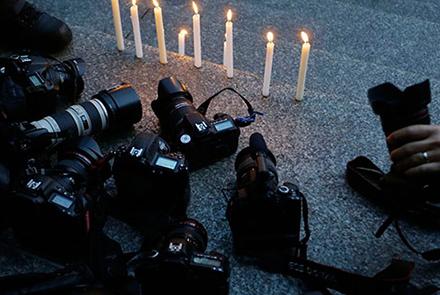The United Nations Educational, Scientific and Cultural Organization (UNESCO) on Friday released a report on journalists’ safety, saying the report is an overview of data collected by the organization on killings of journalists which took place between 1 January 2016 and 31 December 2017.
According to the report, Afghanistan and Mexico were the two countries with the highest number of fatalities in 2016 and 2017.
The report says that in 2017, 13 journalists were killed in Mexico and 11 lost their lives in Afghanistan, while in 2016, both countries each suffered the loss of 13 journalists.
The report says that like in the preceding two-year period, TV journalists constituted the largest group among the victims.
In 2017, almost half of the killed journalists (45%) were working in television outlets while in 2016, those working in this sector represented 34% of all victims, the report says. Among the TV journalists killed in 2016-2017, the majority were killed in countries currently experiencing conflict (55 out of 71 killed TV journalists).
The report says that 19 TV journalists were killed in Afghanistan, 15 were killed in Iraq, six died in Syria and eight in Yemen during the two-year period.
TV journalists, camera operators and support staff such as drivers and technicians regularly work from the frontlines and are therefore under high risk of being killed in crossfire or being targeted directly by parties to the conflict, the report added.
The report says that Afghanistan, Brazil, Guatemala, Pakistan informed of the setting up of monitoring mechanisms to track attacks against journalists.
Afghanistan notified on the establishment of a special committee comprising security agencies and the national journalists’ federation within the auspices of the Ministry of Information to assess the feasibility of prosecuting cases of violence against journalists Afghanistan, the report said.
On journalists’ protection, the reports says, Afghanistan reported providing support through national security forces.
The report also analyzes the status of judicial enquiries of the killings recorded by UNESCO since 2006, based on information made available to UNESCO by Member States.
Three regions recorded the highest numbers of killings in 2016-2017: Arab States, Latin America and the Caribbean and Asia and the Pacific. In 2017, killings in Asia and the Pacific surpassed those that occurred in the Arab States. In both years, less than 10% of overall killings took place in Africa, Western Europe and North America, and Central and Eastern Europe, respectively, the report said.
In 2017, UNESCO recorded the highest number of killed women journalists (11 victims) since the organization started reporting on killings of journalists in 2006, the report said. Men continue to represent an overwhelming majority (86% in 2017) of victims of fatal attacks against journalists.
The report says that in 2017, local journalists represented 90% of all killed journalists and in 2016, 94%. In both years, less than one in 10 of the journalists killed was an international reporter. Of the 14 foreign victims in 2016-2017, half were killed in countries experiencing conflict.
Compared to media staff, freelance journalists are widely considered more vulnerable, since they often lack adequate protection and support from the media organization(s) they are working with. Over the two-year period, 34 out of 182 journalists killed were freelancers, accounting for 19% of all fatalities, the report says.
The report says that in 2017 for the first time in recent years, more journalists (55%) were killed in countries with no armed conflict than in countries experiencing armed conflicts. This trend may possibly be explained by the absence of new armed conflicts and less journalists reporting from long-running conflict areas.
While in the last four years the response rate by Member States had been steadily increasing, from 27% in 2014 to a peak of 74% in 2017; 2018 was marked by a drop in the response rate, with only 64% of Member States providing a reply.
Of the 1010 cases condemned by the Director-General between 2006 and 2017, 115 cases were resolved according to the information provided by the national authorities of the country, the report says, adding that this represents an overall resolution rate of 11%.
Click here for full report.


